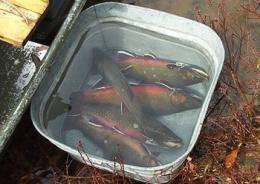Warmer summers could shrink trout populations

(PhysOrg.com) -- The New York state fish could be jeopardy due to climate change, warn Cornell scientists.
Warmer summers mean later fall spawning times and fewer nests for brook trout, which could eventually affect the fish's population numbers.
Cliff Kraft, associate professor in the Department of Natural Resources, and four other researchers looked at 11 years of data from Rock Lake in the Adirondacks to find the link between summer temperatures and spawning times for brook trout. Cornell has a 60-year history of research in Adirondack lakes, providing the researchers with long-term data on temperatures and brook trout spawning times.
"The key thing is they are cold-water fish and need groundwater to spawn," Kraft said.
The warmer summer temperatures have had a "sub-lethal effect," Kraft said. Warmer summers don't kill the fish, but lead to fewer nests -- called redds -- and a late start for those eggs that are laid.
"These trout can't build gonads in the summer," Kraft said. "They're burning more energy to survive, so they don't have energy to produce eggs. The warmer it gets, the fewer fish are spawning; some just give up."
In a study published in the Global Change Biology journal March 13, the researchers argue that temperature can be linked to the delay in spawning.
An average difference in mean summer daily air temperature of 1 degree Celsius delayed spawning by about one week and reduced the number of redds constructed by 65, they found.
"The last brook trout in this lake is not about to drop dead, but warming temperatures present a substantial threat," Kraft said.
Dana Warren, Kraft's former Ph.D. student who is now at Oregon State University, said warmer temperatures also mean earlier ice breaks, earlier turnover times for lakes and earlier peaks for plankton blooms.
All of these factors can affect the food source available for the young fish when they do emerge. If fish are relying on that plankton when they hatch, they may be weeks too late, and the natural synchrony of the blooms and the hatching period are pulled out of whack in two directions, Warren said.
The study used a long time frame to look beyond acute effects and discover potential latent effects of climate change, Warren added.
The researchers believe unstratified lakes -- or lakes shallow enough not to have layers of water at different temperatures and densities -- will become more common. That could pose further threats to fish like trout, which take refuge in cool water, Warren said.
"This study highlights the importance of looking at residency and non-migratory populations," he said.
Provided by Cornell University

















